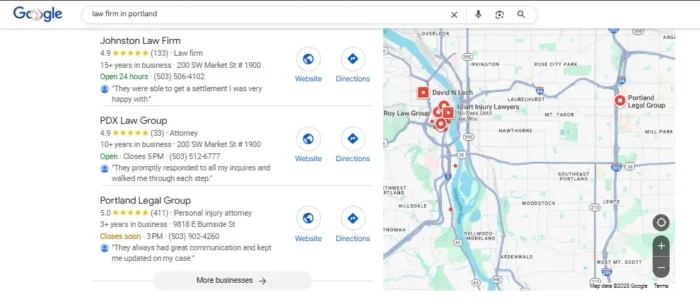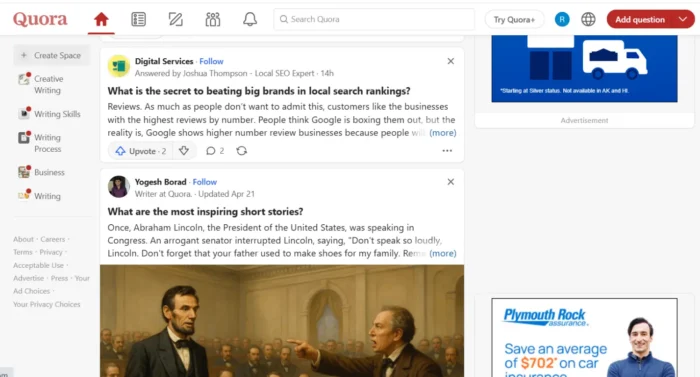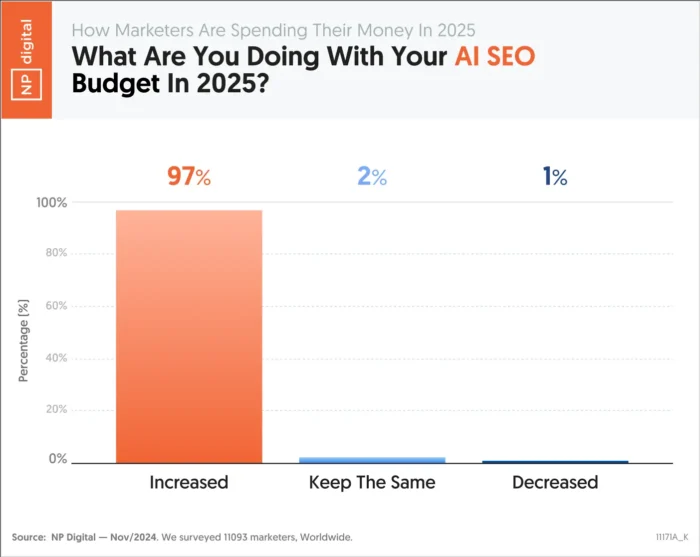How to Use Marketing Attribution to Take Your Business to the Next Level
Marketing today is more complex than ever. With so many channels, touchpoints, and customer behaviors to track, figuring out what actually drives conversions can feel impossible. That’s where digital marketing attribution comes in. It shows you which marketing efforts...
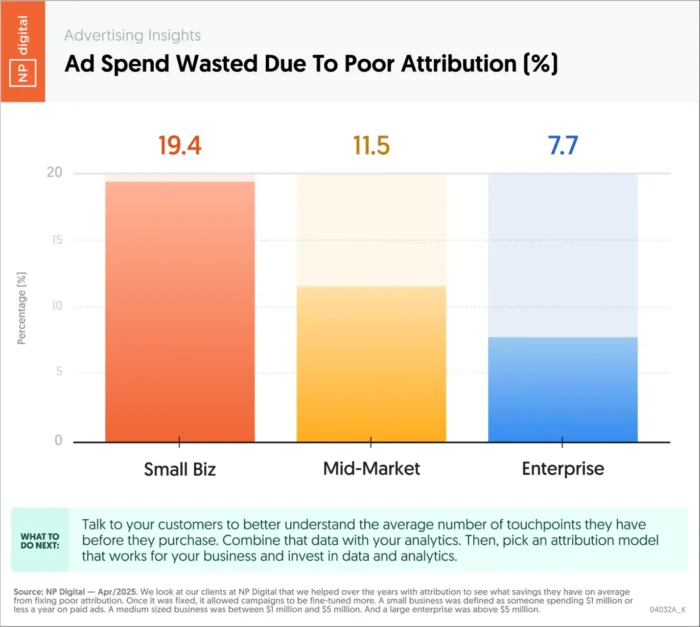
Marketing today is more complex than ever. With so many channels, touchpoints, and customer behaviors to track, figuring out what actually drives conversions can feel impossible.
That’s where digital marketing attribution comes in. It shows you which marketing efforts are working and which ones are wasting your budget.
Without attribution, you’re guessing. With it, you can make data-backed decisions that improve return on investment (ROI) and help you grow faster.
This guide breaks down what attribution is, how different models work, and how to choose the right approach for your business.
Key Takeaways
Digital marketing attribution tracks which channels and touchpoints drive conversions, so you know where to invest your time and budget. There’s no universal “best” model. Each attribution approach has strengths and tradeoffs based on your goals and customer journey. Single-touch models (like first-touch or last-touch) are simple but miss most of the buyer journey. Multi-touch models give you a fuller picture but require more setup and analysis. The right model depends on your business goals, sales cycle length, and how customers interact with your brand.What is Marketing Attribution?
Marketing attribution is how you figure out which marketing efforts actually drive results.
It assigns credit to the touchpoints (ads, blog posts, emails, social posts, webinars) that influence someone to convert.
Think of it as connecting the dots between your marketing spend and your revenue.
When someone makes a purchase or fills out a form, attribution helps you trace the path they took to get there. That insight helps you optimize campaigns, improve ROI, and stop pouring budget into channels that don’t work.
But here’s the problem: most marketers either don’t track attribution at all, or they oversimplify it. Only 28% of marketing professionals say their attribution strategies are very successful at achieving strategic objectives. The stakes of misattribution are high as well, potentially costing companies money and time:

Attribution models set the rules for how credit gets assigned across different touchpoints.
Some give all the credit to the first interaction. Others focus on the last. More advanced models weigh every step of the journey.
Understanding how these models work is the first step to using them effectively.
Why Marketing Attribution is Important
Marketing attribution matters because without it, you’re not measuring performance. You’re guessing.
It connects campaigns to conversions, showing you which efforts drive real impact and which ones drain your budget. The thing about it is it’s also getting harder. Less cookies to rely on and the presence of AI are notable factors.
On top of that, today’s buyer journey isn’t linear. People bounce between search, email, ads, and social, often across multiple devices. Without attribution, you miss the big picture.
That’s especially true if you’re running multi-channel marketing strategies. You might be getting results, but you can’t tie them back to the right touchpoints.
Take a look at what channels marketers are the most confident in when it comes to attribution:
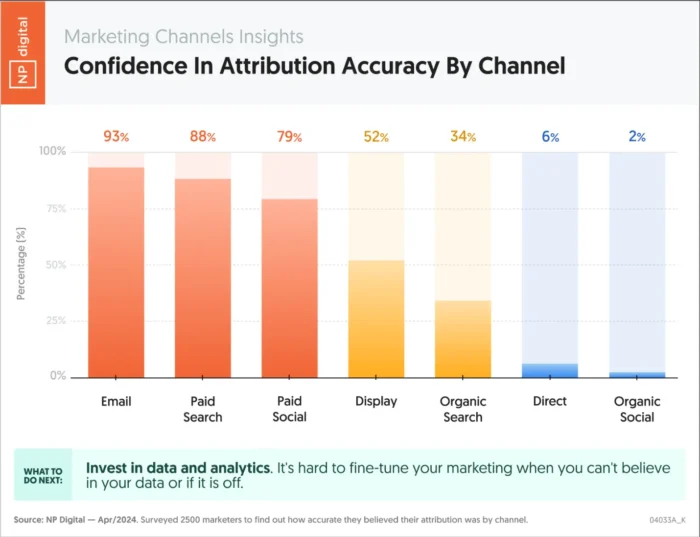
Email and paid top the list. But here’s the thing: without proper attribution, you can’t tell if any channel is actually driving growth for your business, or if you’re just following what everyone else is doing.
Attribution also improves ROI. When you know what works (and what doesn’t), you can reallocate spend with confidence.
It gives marketing teams clarity, sales teams better leads, and leadership the data they need to make informed decisions.
Bottom line: attribution turns marketing from a cost center into a strategic growth engine.
Types of Marketing Attribution Models
There’s no one-size-fits-all approach to marketing attribution. Only what fits your business best.
Attribution models fall into two categories: single-touch and multi-touch.
Single-touch models give full credit to one touchpoint, like the first click or final conversion. They’re simple to track but miss most of the customer journey.
Multi-touch models spread credit across multiple interactions. They take more effort to set up but give you a clearer picture of what drives revenue.
Let’s break down each model so you can find the right fit for your goals.
Option #1. First-touch attribution
The first-touch attribution model applies all the ‘credit’ to touch points that lead a visitor to your website for the very first time.
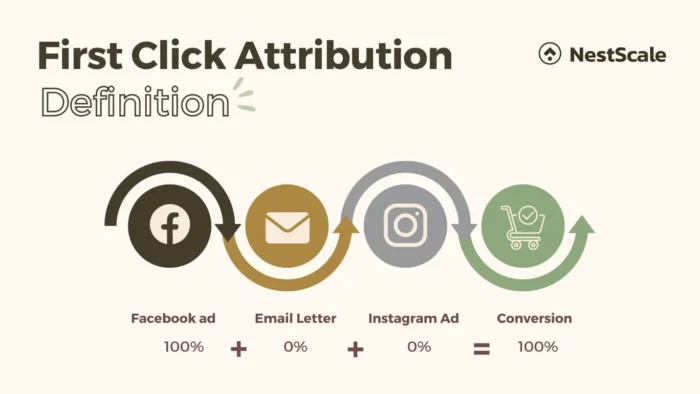
That holds true even if they don’t make a purchase, subscribe to your email list, or complete any other converting action.
This model is all about the very first part of the customer journey. It’s the first few steps someone takes to visit your site for the very first time.
That’s why it works best for marketers who are focused on demand generation and lead forms. You want to see which actions are driving that very first connection with your brand.
A good thing about this model is that it’s pretty simple to put into effect with Google Analytics.
But, since this model only really focuses on one single touch point, it tends to over-prioritize a channel that might not be the most important.
In other words, the initial social ad used to drive traffic is important to an advertiser or brand marketer. However, it’s not all that helpful to people who are analyzing bottom-of-the-funnel conversions, that generally lead right to a sale or conversion.
The first-touch attribution model also doesn’t actually uncover what made a customer buy, so it doesn’t really allow for a whole lot of optimization.
Option #2. Last-touch attribution
The last-touch attribution model is the exact opposite of the first-touch attribution model, hence the name.
It’s often the “default,” go-to model for most marketers. It gives all the credit to the final touch point before someone buys.
For example, if a customer clicks a retargeting ad and buys, last-touch attribution credits that final ad, even if they interacted with your brand five times before that.
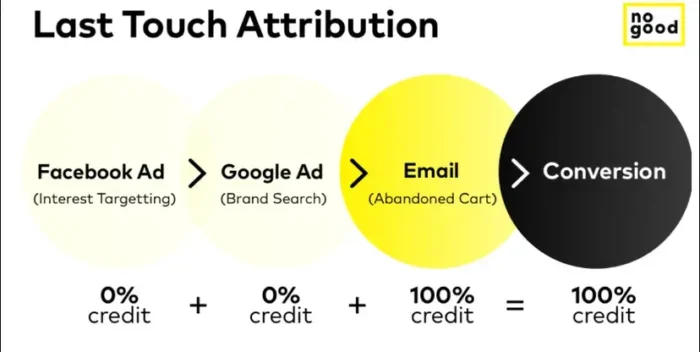
This model puts all the attention on the very end of the customer journey. The items are “in their carts,” so to speak.
This model is great for short sales cycles or conversion-focused teams.
But it ignores all of the factors that influence a customer’s journey to purchase by putting all of the attention on the final interaction.
If you’re using Google Analytics, try looking at Last Non-Direct Click instead. It skips direct visits (like people typing your URL) and highlights the last true channel that drove them in.
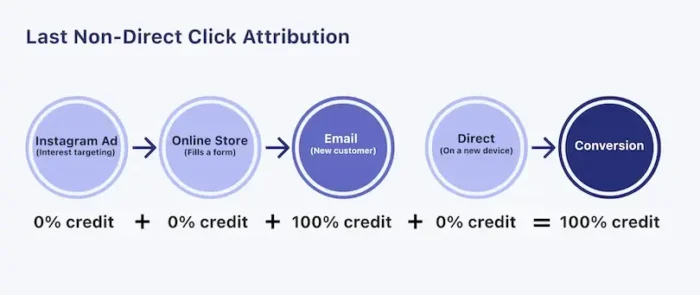
Option #3. Lead-conversion touch attribution
The lead-conversion touch attribution model assigns 100% of the credit to the interaction that generated a lead.
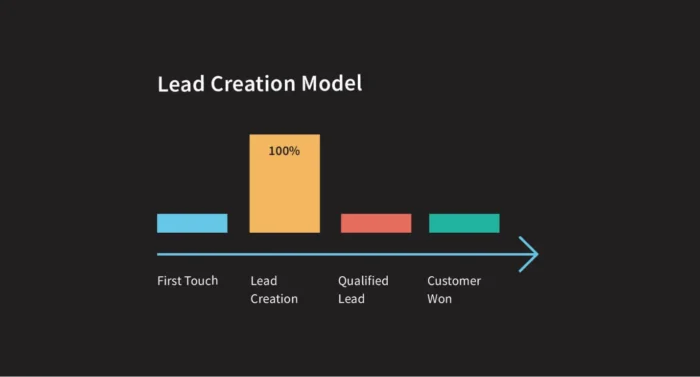
It’s a popular option in B2B and lead-gen-focused businesses because it gives a clear signal: which campaign, offer, or page got someone to convert.
This is helpful when you’re trying to understand what sparks initial interest, especially if you’re optimizing for marketing qualified leads (MQLs) or sales-qualified leads.
But like other single-touch models, it only highlights one moment in a longer journey.
That means it misses the role of earlier awareness-building and any post-lead nurturing that helps close the deal.
If you’re using this model, be careful not to over-prioritize top-performing lead channels at the expense of brand-building or retention tactics.
It works best when used alongside other models that measure pipeline movement or final conversions, not as a standalone view.
Option #4. Linear attribution
The linear-attribution model splits credit up evenly across every touch point of the customer journey.
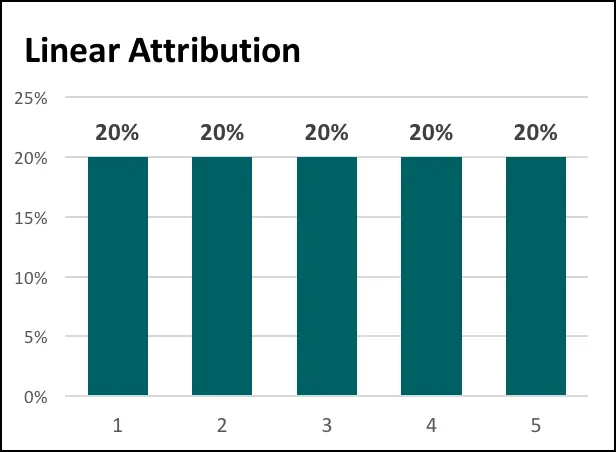
So, if there are five touch points, every touch point gets 20% of the credit. For ten touch points, each touch points gets 10%, and so on.
This model lets marketers make the best of the customer journey as a whole and optimize the entire picture, rather than just focusing on one touch point.
But, since it gives credit to all touch points evenly, some high-performing points will get less credit than they deserve, and some low-performing ones will get more.
Still, it’s a good starting point for teams who want a more balanced look at what’s working across their funnel, without needing complex analytics setups.
It can also serve as a baseline model for comparison when testing more advanced multi-touch approaches.
Option #5. Time-decay attribution
The time-decay attribution model gives more credit to touchpoints that occur closer to the final conversion.
In this setup, the last few interactions (like an email click or retargeting ad) carry more weight than earlier touchpoints.

This model makes sense for longer journeys, where timing and momentum are critical to pushing someone across the finish line.
It also reflects how user behavior changes closer to conversion. Someone may browse casually at first, but act with more intent later.
However, time-decay can undervalue the early-stage marketing that sparked interest in the first place. That means awareness efforts like content or top-of-funnel ads may look less effective than they really are.
If you’re running nurturing campaigns or have a long sales cycle, time-decay can give you insight into what’s accelerating purchase decisions, even if it doesn’t tell the full story.
Option #6. U-shaped (position-based) attribution
The U-shaped attribution model, also known as the position-based attribution model, gives 40% of the credit to the first and last touch points.
Then it splits up the remaining 20% among each of the touch points in between.

This setup recognizes the importance of both the entry point and the final push, while still accounting for the journey in between.
For example, if someone finds you through a blog post, returns via email, then converts after clicking a retargeting ad, both the blog and the ad would receive the highest share of credit.
This model is a popular middle ground. It highlights the two most critical steps without ignoring everything else.
This model might give inaccurate credit to the first and last touch points in the customer journey, though.
They receive a large, fixed percentage. So you might still see some over-reporting on both ends of the journey.
Still, for many teams, U-shaped attribution offers a practical balance of simplicity and nuance.
Option #7. Custom or algorithmic attribution
Custom, or algorithmic, attribution starts to get technical.
A data scientist creates and builds a model for attribution that matches the customer journey of a certain business in a precise way.
These models analyze your actual conversion paths and weigh each touchpoint’s impact accordingly.
That means your attribution is specific to your business, your audience, and how they buy.
It’s by far the most accurate model, but also the most complex to build.
You’ll usually need a data science team or an advanced analytics platform to get started. That makes it tough for lean teams or smaller organizations to implement.
Still, some platforms now offer algorithmic models out-of-the-box, giving you smarter attribution without having to build it from scratch.
If your marketing is already scaled and data-driven, this model can reveal deep insights you’ll never get from basic reporting.
Option #8. Rules-based attribution
Rules-based attribution lets you define how credit is assigned across the customer journey based on your own logic, not a fixed formula.
For example, you might assign 20% of the credit to first-touch, 20% to last-touch, and distribute the remaining 60% based on engagement or funnel stage.
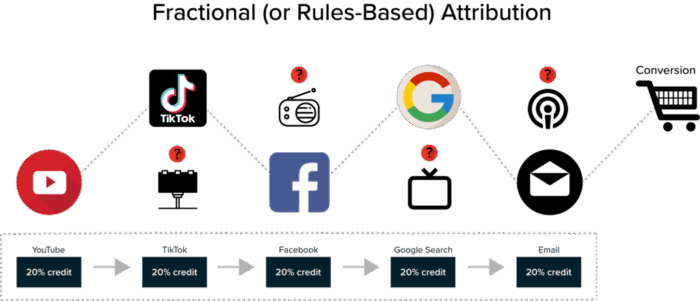
This approach gives you more control and customization without requiring advanced AI or machine learning.
It’s especially useful when you have a clear understanding of your sales cycle and buyer behavior, or when you need to align attribution with internal KPIs.
The downside? It’s still built on human assumptions. If your weighting is off, your data might mislead you.
Rules-based attribution works best for marketing teams that want more flexibility than single-touch or rigid multi-touch models but don’t have the resources for full algorithmic setups.
Option #9. W-shaped attribution
W-shaped attribution is a multi-touch model that assigns credit to three key moments: the first interaction, the lead conversion, and the opportunity creation.
Each of these gets 30% of the credit, with the remaining 10% spread across other touchpoints.
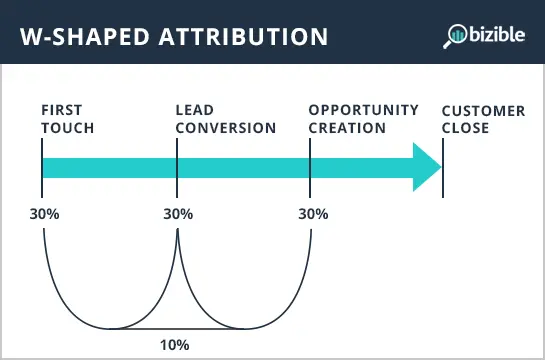
This model is particularly useful for B2B marketers who track leads through a defined sales funnel. It focuses on the moments that signal serious interest, not just casual engagement.
For example, a user might find your blog via search (first-touch), download a gated guide (lead conversion), and attend a webinar (opportunity creation).
W-shaped attribution highlights these hand-raising moments while still acknowledging the rest of the journey.
Downside? It assumes every journey fits that mold. Not every customer goes through clear-cut milestones, especially in shorter or less structured funnels.
If you’re managing long, complex buyer journeys, this model gives you more granularity than U-shaped without requiring full customization.
Option #10. Data-driven attribution
Data-driven attribution uses machine learning to assign credit based on how different touchpoints actually contribute to conversions, not predefined rules.
Unlike linear or position-based models, it adapts over time based on real behavior.
Platforms like Google Analytics and certain CRMs offer this as a built-in model, making it more accessible than full-blown custom attribution.
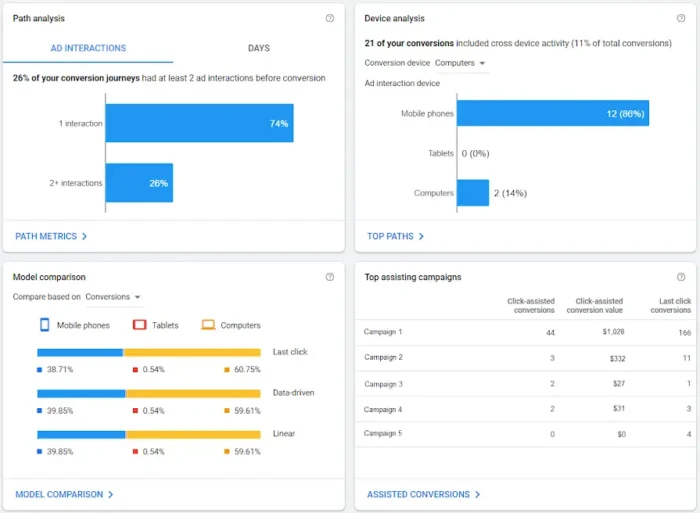
The system looks at all conversion paths and analyzes what works best, distributing credit accordingly.
This gives you a more objective view of what’s really influencing performance, without the bias of manual weighting.
Of course, the quality of your attribution is only as good as your data. Inaccurate tracking, broken events, or missing conversions will lead to flawed insights.
How To Choose the Right Attribution Model for Your Business
There’s no single “best” attribution model. The right choice depends on your funnel, goals, and how much data you have access to. Here’s how to approach it:
Map the Customer Journey
Start by understanding how people discover, engage with, and convert on your site.
Look at your customer journey mapping or analytics tools to spot patterns in behavior. If most users follow a simple path, single-touch might work. If they interact across multiple channels, you’ll want a multi-touch model.
Define Actionable Goals
Your attribution model should help you make better decisions, not just report on past performance.
Are you trying to lower acquisition costs? Improve lead quality? Shift budget to better-performing channels?
Pick a model that aligns with your strategic focus.
Prioritize Lead Quality
Don’t just track what drives volume. Focus on what drives high-quality leads or customers.
Website traffic and leads are common examples, but those are vanity metrics if they don’t convert into revenue.
Attribution tied to lifetime value (LTV), conversions, or revenue will give you far more insight than clicks or impressions.
The best attribution models connect marketing activity to actual business outcomes, not just top-of-funnel metrics.
Test and Adjust Over Time
No model should be static. As your campaigns evolve, revisit your attribution model regularly.
Consider running model comparisons inside tools like Google Analytics or your CRM to see how attribution shifts under different assumptions.
Common Digital Marketing Attribution Challenges
Even with the right model, marketing attribution isn’t always easy to get right. Here are some of the most common roadblocks teams run into:
Incomplete or inaccurate tracking: If events aren’t firing properly or conversions aren’t tagged, your data will be flawed, no matter what model you use. Cross-device behavior: A user might research on mobile but convert on desktop. Without unified tracking, you’re missing part of the journey. Platform silos: CRMs, ad platforms, and analytics tools don’t always talk to each other. That can lead to duplicate or fragmented data. Lack of internal resources: Attribution often requires analysts or at least someone who can set up and maintain tracking, and not every team has that bandwidth. Misaligned KPIs: When sales, marketing, and leadership define “success” differently, attribution insights can get lost or misused.Solving attribution challenges often means improving operations, not just picking a better model.
Attribution Model Reports in Google Analytics
Google Analytics 4 (GA4) includes built-in attribution model reports that help you compare how different models assign credit to your conversions.
This is a powerful way to explore which marketing channels contribute most to your results and how your view of performance changes depending on the model you choose.
You can find attribution reports in GA4 by navigating to:
Reports → Advertising → Model Comparison
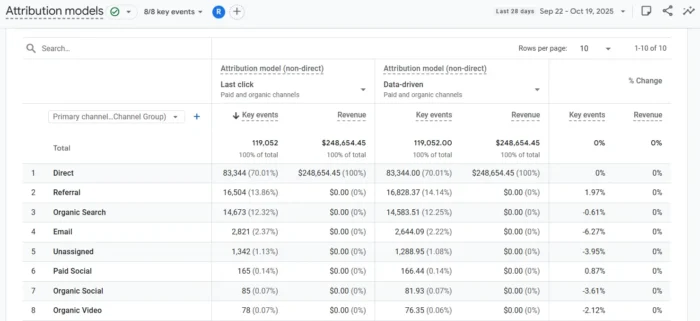
There, you can select multiple models (like last-click, first-click, linear, or data-driven) and view side-by-side results.
This helps you spot where credit might be over- or under-assigned based on your current model.
For example, your email channel might perform better in a linear model than a last-click one, revealing a need to rebalance budget or expectations.
Even if you’re not ready to commit to a new attribution approach, GA4’s model comparison is a low-risk way to experiment and build attribution literacy.
Additional Attribution Software Options
Not every team needs a custom attribution setup, but the right software can make a huge difference.
Platforms like SEMrush, HubSpot, Google Analytics 4, and Wicked Reports offer built-in attribution tools to help you get started without hiring a data science team.
SEMrush and HubSpot are especially helpful for combining attribution with broader campaign management and reporting.
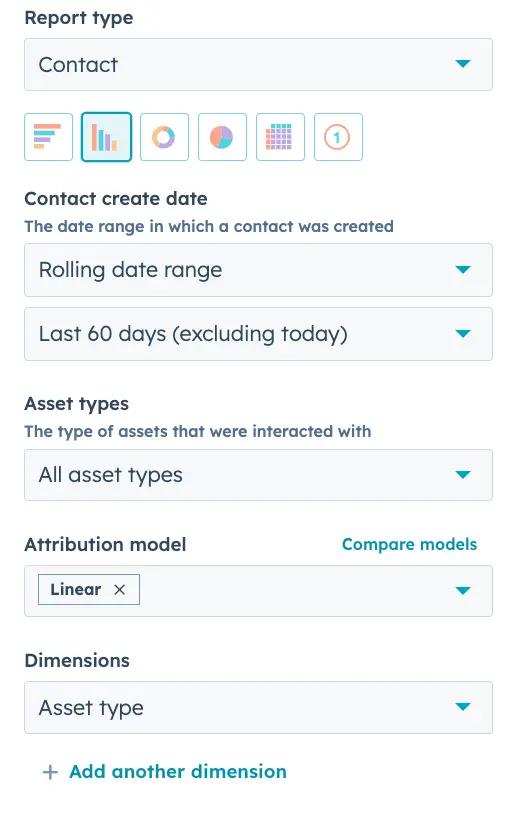
For more advanced needs, tools like Dreamdata or Funnel.io can integrate data across multiple platforms to give you a unified view of the buyer journey.
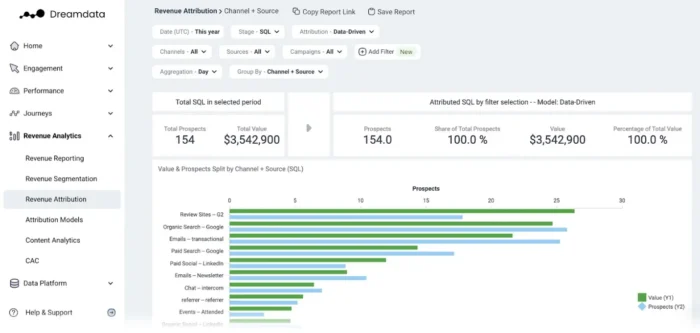
The key is making sure your tools match your actual marketing complexity. If you’re not tracking conversions accurately or aligning on KPIs, no tool will magically solve that.
Use software to simplify attribution workflows, not replace strategy.
FAQs
Attribution in marketing refers to how credit is assigned to different touchpoints that lead to a conversion.
Whether it’s a first-click blog visit or a final retargeting ad, attribution shows you which parts of your funnel are influencing behavior and how to optimize for more impact.
What attribution model approach is mainly used in marketing?
Last-touch attribution is still the most commonly used model, mostly because it’s simple and built into most ad platforms and CRMs.
But that doesn’t mean it’s the best option. Many teams are now moving toward multi-touch or data-driven models as campaigns get more complex.
Why is attribution important in digital marketing?
Attribution gives you the visibility to connect marketing efforts to actual business outcomes.
Without it, you’re just guessing what works. With it, you can prioritize the right channels, improve ROI, and cut spend where it’s not performing.
What is an example of attribution in marketing?
Let’s say a customer first finds your site through organic search, then clicks a retargeting ad, and finally converts from an email offer.
Depending on your attribution model, credit could go to the search, the email, or all three.
That model determines how you report success and where you double down in future campaigns.
Conclusion
Now that you understand how marketing attribution works, you can focus on the right touchpoints without all the guesswork.
This means no more wasted spend on channels that aren’t moving the needle.
Choose between first-touch, last-touch, lead-conversion, linear, time-decay, position-based, or custom attribution models to determine how your efforts contribute to conversions.
Just remember: no single model works for every business. The right choice depends on your campaign goals, customer journey, and how you define success.
Start with a basic model, then build from there. Use tools like Google Analytics or customer journey mapping to improve visibility across your funnel.
Test often, stay flexible, and evolve your strategy as your data improves.

 Tfoso
Tfoso 









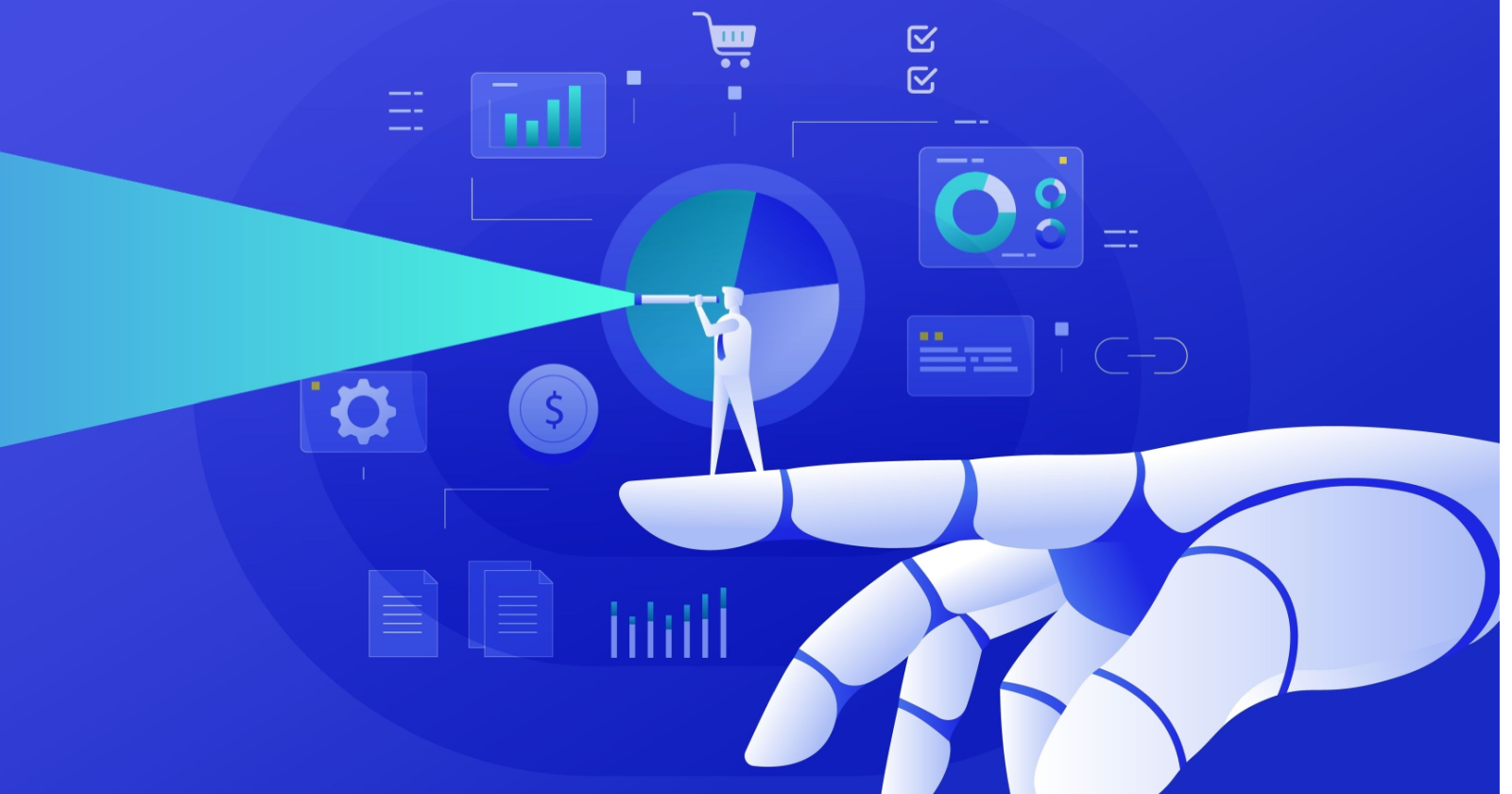






.jpg&h=630&w=1200&q=100&v=6e07dc5773&c=1)


